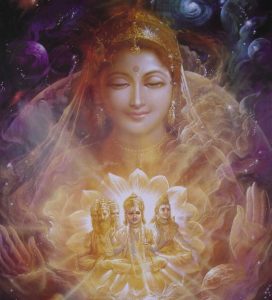 According to schools of Shaivism and Shaktism, Parashakti is the projection of the dynamic or kinetic energy of the Infinite Divine Being, Paramshiva. This Shakti co-exists with the Infinite and is in essence one unit; a clear demonstration of unity in duality. One is but the expression of the other. Just as a word and its meaning are one, as the ocean and the waves are one, as the fire and the burning power are one, so too, Paramshiva and Paraashakti are one.
According to schools of Shaivism and Shaktism, Parashakti is the projection of the dynamic or kinetic energy of the Infinite Divine Being, Paramshiva. This Shakti co-exists with the Infinite and is in essence one unit; a clear demonstration of unity in duality. One is but the expression of the other. Just as a word and its meaning are one, as the ocean and the waves are one, as the fire and the burning power are one, so too, Paramshiva and Paraashakti are one.
By the devolution of latent energy of Paramshiva or the primordial matter which is present before the creation of the world, Shakti manifests into the entire material world of animate and inanimate objects. This manifest world, with all its diversity of names, forms, space, time and causation is referred to as sansaar or Brahma Prapanch.
Shakti is the instrumental cause of this sansaar. It is the dynamic force animating all of creation. This universal energy is personified as Devi, the Divine Mother. She is the heartbeat of the physical world; every atom created is the manifestation of Devi Herself. Every object and being is encapsulated in forms with energy vibrating at different frequencies. Every thought, word or action is governed by this power. Without the presence of Shakti, all creation would be rendered impotent.
The following Sanskrit lines describe the all-encompassing nature of Devi:
Ya Devi Sarva Bhuteshu Sarva Rupena Sansthitaa,
Namastasyai, Namastasyai Namastasyai Namo Namah.
Prostrations again and again to You Devi who abides in every form of creation.
Devi And The Manifest World
The factors of space, time, causation, together with the three qualities of nature or ‘gunas’: ‘sat’(purity), ‘raj’(egoism) and ‘tam’(lethargy) and the main functions of creation, sustenance and dissolution all constitute the entire created world. These nine factors also explain the significance of the number nine as it relates to Devi.
While all schools of Hindu philosophy maintain that man’s Supreme Objective is to transcend this material world and attain the state of Divine Consciousness, it may be instructive to consider the varying views on the significance of the manifest world in achieving this goal. Shri Shankaracharya of the Advaita Vedanta School of thought enunciates that the created world is unreal or false.
‘Maayaa’ or an illusion of individuality is the condition ascribed by Shaivism to the individual whose consciousness remains firmly entrenched in the mundane. The power that identifies with such worldliness, materialism and objectivity clouds man’s vision from identifying with divinity. Such a power is referred to as ‘Maayaa Shakti’. This is opposed to ‘Chid Shakti’, the power of pure consciousness, a state to which everyone should strive to attain.
The school of Shaktism postulates that the gross material world is a necessary pathway that must be traversed in the journey towards Divinity, to the state of Chid Shakti. This school also places prime emphasis on the human body, as a blessed vehicle for spiritual unfolding. On such a journey, Devi facilitates the transcendence over materialism. Devi symbolizes the higher self, the state of positive qualities, purity, awareness and spirituality. She is the personification of Chid Shakti. Through the worship of Devi, Maayaa Shakti is transformed to Chid Shakti. It is Devi who takes one to Shiva.
This merging of Shiva and Shakti is iconographically represented in the form of Ardhanarishwar, which means half Devi and half Shiva. Most certainly, the mother knows who the father is and none but the mother can take the child to his/her father.


